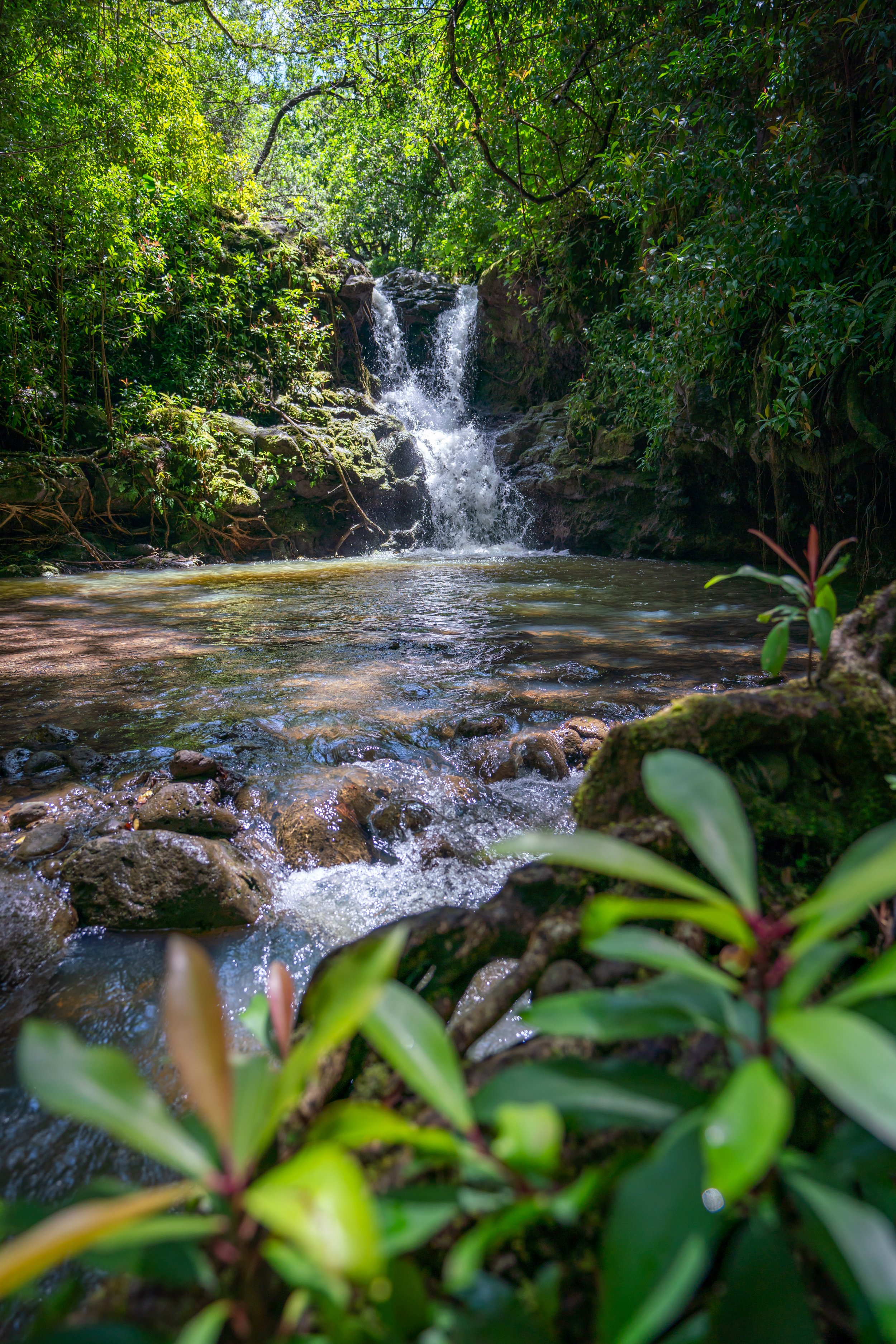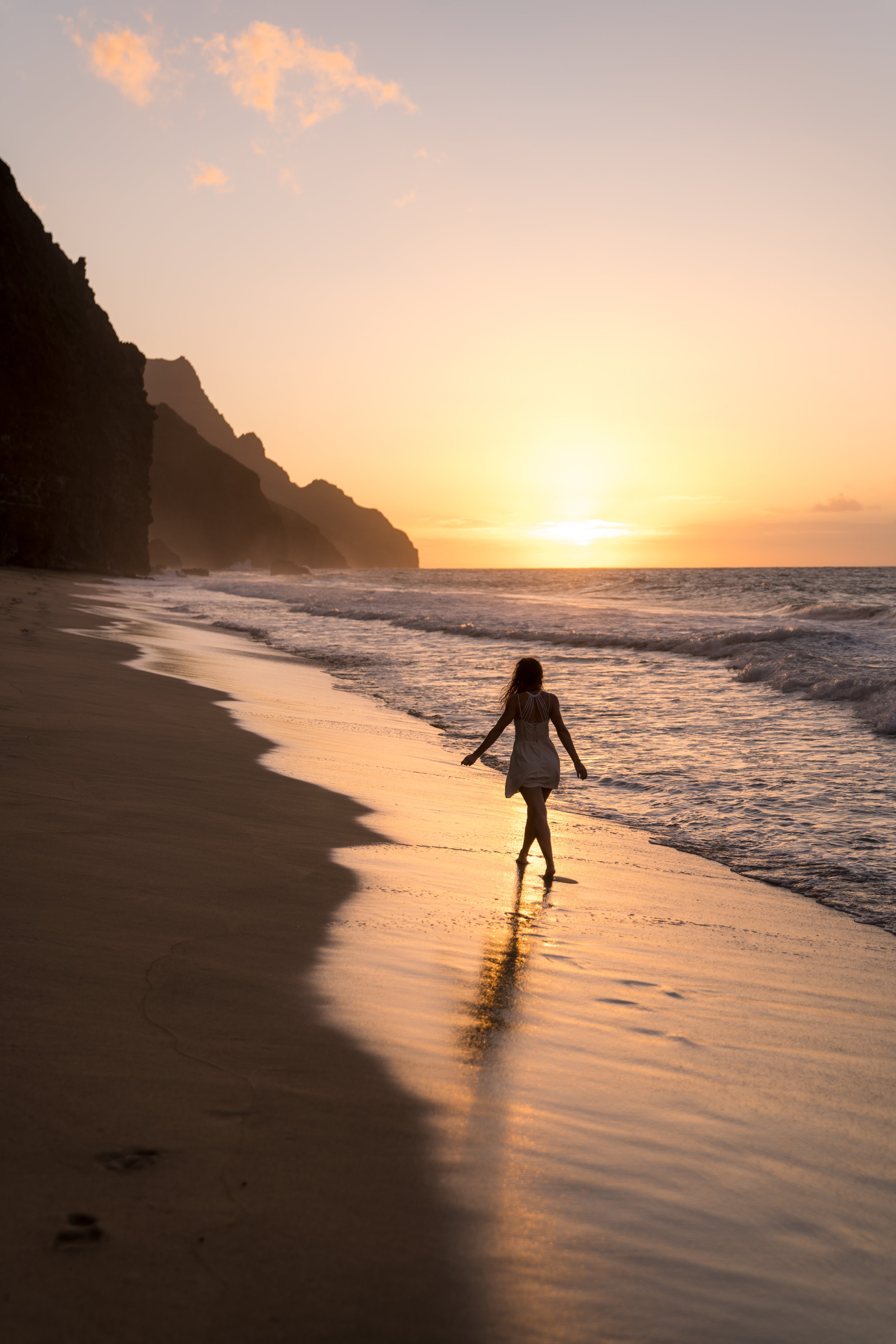What is the Best Time of Year to Visit Hawaiʻi?
To answer the question, 'What is the best time of year to visit Hawaiʻi?' I want to say: your guess is as good as mine!
However, in all seriousness, Hawaiʻi is known for having both a wet season from November through March and a dry season from May to September.
Now, simply saying that it’s best to visit during the dry season isn’t as straightforward as it may seem. In fact, the cover photo above was taken on Kauaʻi’s Nāpali Coast in February, surrounded by weeks on both sides of our trip that would not stop raining.
So, I say again: your guess is as good as mine, and amazing weather can be found throughout the year, meaning that if you have the flexibility to plan your trip at any time, there is a lot more to consider. This includes when the whales come to Hawaiʻi, the winter waves, the seasonal rain, what activities you’re most interested in, which island you plan to visit, and which sides of each island you’re most interested in seeing and staying on.
Things like elevation, the wet and dry side of each island, and what you plan to do can say a lot more about when it’s best to visit than the weather alone. Therefore, I highly recommend reading through the full article below to understand my overall opinion on the best time of year to visit the islands!
What is the Best Time of Year to Visit Hawaiʻi?
In order to answer this question, it’s best to first understand the weather in Hawaiʻi.
Hawaiʻi’s Weather
Hawaiʻi’s beautiful year-round conditions have a lot to do with where the islands are situated in the North Pacific. By this, I mean that the Hawaiian archipelago is 'barely' in the tropics, only about 69 miles (111 km) south of the Tropic of Cancer north of Kauaʻi.
This makes the waters around the Hawaiian Islands relatively cooler compared to other places in the Pacific, like Tahiti. In addition to this, Hawaiʻi typically receives its weather from trade winds that travel from east to west, as opposed to the mainland U.S., where weather travels from west to east.
This means that the east side of all the six main islands are typically wetter than the west sides, as the moisture carried in with the clouds hits the steep mountains and turns into rain on the east sides and leeward valleys.
This can most prominently be seen on a Google Maps satellite view of the islands, where the east sides will look noticeably greener than the west sides.
Given everything mentioned above, planning a trip in the middle of the winter can often be a be gorgeous stay if you plan on booking a place somewhere like Kīhei or Lāhainā, Maui, as the wet winter weather is almost always blocked by Haleakalā or the West Maui Mountains.
However, the same can’t be said about Kauaʻi, also called the Garden Isle, because the island’s interior is mountainous. This means that the places where you would likely be staying, typically from the South Shore in Poʻipū to the North Shore in Hanalei, would receive the most rain when the clouds hit the mountains.
Therefore, I truly do mean that elevation, what island you plan to visit, and what and where you plan to go and do has a lot to say regarding what kind of experience you can expect.
A general rule of thumb is that east is wetter and west is drier, which also corresponds to elevation, where low is typically drier and high is typically wetter until the elevation begins to exceed 6,000 ft. (1,829 m) on both Maui and the Big Island.
Summer vs. Winter Activities in Hawaiʻi
When it comes to what you plan to do in Hawaiʻi, there are some things to consider.
For example, Humpback whales in Hawaiʻi are seasonal to the winter only, but dolphin and turtle tours, especially on Oʻahu, are considered to be a year-round activity.
With that in mind, the things that you may want to do outside, like hiking and going to the beach, may seem best during the summer dry season, but the hottest months can make hiking Hawaiʻi’s steep trails considerably more difficult than they would be at cooler times of the year. I personally like to say that when it’s winter, cool, and clear, it’s the best hiking weather on the planet, which is exactly what we experienced that February on the Nāpali Coast.
Furthermore, the dry summer weather can also mean that hiking popular trails, such as the Mānoa Falls Trail on Oʻahu, wouldn’t be the same experience in August as it would be in January, being that the stream is rain-fed. This means that many summer visitors may only see a trickle or even a dry waterfall compared to what it normally looks like at other times of the year.
On the contrary, when the weather is the wettest on Kauaʻi, getting outside might seem like a bad idea, but heavy rain is what can make a helicopter tour the most beautiful, as typically dry waterfalls come to life across the Waimea Canyon and Nāpali Coast!
This is all to say that it’s truly up for debate regarding whether it’s best to plan a trip during the dry or wet season. It’s all personal preference, and it all depends on what you’re most interested in seeing and doing.
The last main consideration has to do with going to the beach.
Hawaiʻi is known for its famous world-class winter surf because storms that occur up in Alaska generate swells that travel throughout the Pacific, creating huge waves that break when these swells hit the reefs surrounding the Hawaiian Islands.
That being said, the shore break at beaches across Hawaiʻi can be the most extreme of any place in the world, and all too often, visitors around the state end up paralyzed because they try swimming in the shore break.
However, this is not to say that visiting during the winter isn’t a good time, as the winter waves can make for a fun time to watch some of the best surfers in the world, which is especially true on on Oʻahu’s North Shore! To truly appreciate this, I personally recommend hiking the ʻEhukai Pillbox Trail, as it makes for an amazing lookout to sit back, relax, watch the sunset, and watch the huge waves break along the beaches across Pūpūkea!
This all goes without saying: Yes, there are beaches that are calm year-round—like Waimānalo on Oʻahu or Poʻipū on Kauaʻi—but the warning mentioned above should be taken seriously when swells are elevated. For the most part, this occurs in winter across the north- and west-facing shores, as well as in summer on the south- and east-facing shores.
What is the Best Time of Year to Visit Hawaiʻi?
So, given all the considerations mentioned above, my answer for the best time of year to visit Hawaiʻi is the shoulder seasons, meaning April and October, with my overall recommendation leaning toward October.
I say this because these are the times of the year when the weather isn’t too hot or too wet, and the kids are in school, which in turn means there are typically fewer visitors throughout the islands.
That being said, there are always exceptions to this thinking, like if a winter runs particularly long or the hottest months (August–September) extend into October. However, for the most part, these are the most desirable times of the year to visit Hawaiʻi, given all the considerations to keep in mind, like the weather, the waves, and the number of people traveling to the islands.
My Hawaiʻi Hiking Checklist
Osprey 3L Water Bladder - The Osprey 3L water bladder is the most universal hiking and backpacking water bladder on the market, and it’s my go-to because of the slide-off seal that allows it to be quickly filled from the top. Additionally, individual parts are easily replaceable, such as the bite valve.
Blister / Heel Protectors - I swear by these cheap, amazing heel protectors to prevent blisters for nearly every kind of hiking and backpacking that I do!
Black Diamond Headlamp - Personally, I recommend the Black Diamond Storm because it is one of the brightest, lightest, and longest-lasting headlamps on the market—and trust me, the weight-to-battery-life ratio really does matter!
Hiking / Trail Running Shoes - Depending on the type of trail, I prefer to use either the Keen Targhee for longer, more rugged hiking or the HOKA Zinal Trail-Running Shoe for lighter, less intense trails. In either case, both have been amazing to me for many years across countless environments, and both can be found in men’s and women’s sizes. - (Men’s Keen / Women’s Keen) (Men’s HOKA / Women’s HOKA)
Waterproof Rain Shell - You never know when it may rain, and I’ve learned over the years that a rain shell is far better than a rain jacket. By this, I mean that it’s best to have something that the water will roll right off of, which is why I recommend the Patagonia Torrentshell 3L available in both men’s and women’s sizes.
High SPF Sunscreen - Packing high-SPF sunscreen is a must for long days outside!
More Oʻahu Adventures
If you’re interested in reading about some more amazing Oʻahu adventures, check out my separate posts below!
Best Hotels & Restaurants in Waikīkī
If you’re trying to decided where to stay on Oʻahu, check out my top 10 list for the best resorts and restaurants in Waikīkī.
I break down what makes one hotel a better choice over another, so that you can find the best fit for your stay on the island.
Read My Separate Post: Best Waikīkī Hotels & Restaurants
HNL Airport-Hotel Shuttle
Prices on ride-share apps like Uber/ Lyft cannot beat the price of booking your hotel shuttle prior to arrival. I say this because there are additional fees for ride-share airport pick-ups at Honolulu Airport (HNL), which is why I recommend booking your transportation in advance using the options below.
Additionally, the last option below will go as far as the Ko ʻOlina Resorts on the West Side and Turtle Bay on Oʻahu’s North Shore!
Best Way to Book Rental Cars!
I travel quite a bit, and I know firsthand that finding a good rental car deal can be a challenge, but that’s why I recommend comparing all of your options with Discover Cars.
In short, Discover Cars is a well-known, reputable business that allows you to search for the best deal across companies, and they have the best full-refund cancellation policy I’ve ever seen, valid up to 72, or sometimes even 48, hours prior to your reservation!
Book Here: Discover Cars
Visiting Other Islands
If you are visiting Oʻahu or heading to another island, check out some of my personal recommendations for Oʻahu, Maui, Kauaʻi, Molokai, Lānaʻi, and Hawaiʻi Island (Big Island) in these separate posts.
If you’re trying to decide which island is right for your visit, check out my overview about each island in the post below.
Read My Separate Post: What is the Best Hawaiian Island to Visit?
What is the Best Time of Year to Visit Hawaiʻi?
The weather in Hawaiʻi can often appear to be warm and beautiful throughout the year, but in my experience, there is a lot more to consider when planning what time of year to visit the islands, such as what island you are considering, what sides of each island do you plan to stay, what activities are you most interested in, the wildlife, and countless other nuanced variables that can all impact the type of trip you can expect to have.
For these reasons, I highly recommend reading through my separate article to not only understand my thoughts regarding the best time of year to come to Hawaiʻi but also what you need to consider based on the time of year that you plan to visit.
Read My Separate Post: What is the Best Time of Year to Visit Hawaiʻi?
10 Best Tours & Excursions on Oʻahu
There are a lot of different tour options to choose from on Oʻahu, but to make it easier to decide, I made a list of my favorite tours because some things simply are better with a local guide!
Read My Separate Post: Best Tours on Oʻahu
Safety
All hikes in Hawaiʻi should not be compared to trails outside of the islands, and hikers should exercise due caution on every adventure, given that many are extremely dangerous.
By this, I mean that Hawaiʻi is known for hot, humid weather, steep, dramatic, and unstable cliffs, and flash floods, which can occur without warning. Therefore, it is important that you check the local forecast, understand the physical condition of your entire group, and pack sufficient food and water before attempting any adventure.
Disclaimer
All information provided on this blog is for informational purposes only and is not intended to be a substitute for information or advice from qualified professionals or managing agencies.
Noah Lang Photography LLC makes no representations or warranties regarding the accuracy or completeness of the information provided here, and readers should use their own discretion, judgement, and seek professional advice where it is appropriate.
Furthermore, Noah Lang Photography LLC shall not be held responsible for any injuries, lost individuals, or legal issues arising from the use of information provided on this website, and if applicable, the above safety disclaimer should be referenced to provide a generic overview of the risks involved.
All said, the content on this blog is for the sole use of Noah Lang Photography LLC, and unauthorized use or reproduction of this content is strictly prohibited.
Disclosure
This post is not sponsored.
However, some of the links in this post are affiliate links, which means that I may earn a small commission if a purchase is made through one of those links. This commission comes at no additional cost to you, and I only recommend products that I personally use and believe will add value to my readers. Thank you for your support, which enables me to continue creating more!
To read the full privacy policy, click here.

About This Blog
Noah Lang Photography, also known as @noahawaii, is 100% reader-supported!
I do not accept guest articles or sponsored content of any kind on my blog, which is why, if you enjoy the outdoor and travel content I create, please consider buying me a coffee!
I appreciate your support, which helps me continue to keep this blog alive!




























